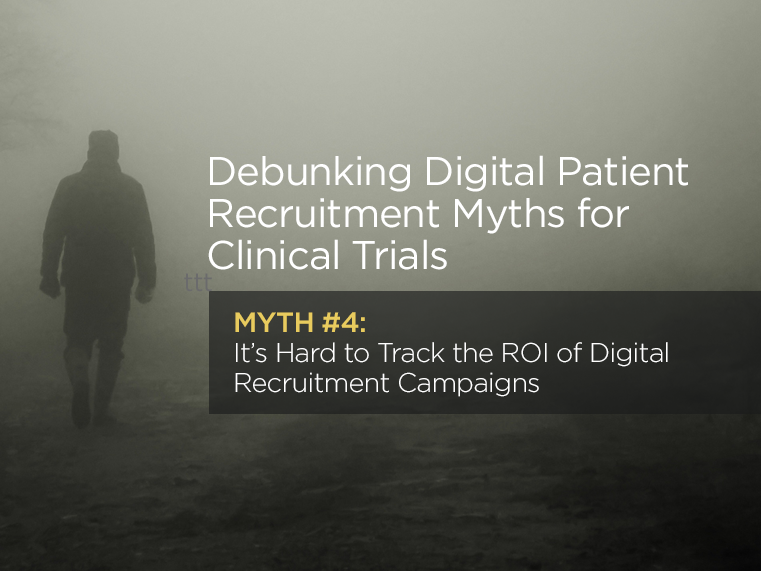Debunking Digital Patient Recruitment Myths for Clinical Trials: Myth 4

When it comes to clinical trial recruitment, fiction often rules the day. In this series, we debunk some of the most common misperceptions about digital recruitment for clinical trials, and set the record straight with hard facts and actionable solutions.
“It’s Hard to Track the ROI of Digital Recruitment Campaigns”
There is a common misconception in the clinical trial space that the ROI is difficult to track for digital recruitment campaigns. Without a concrete proof of concept in hand, many clinical recruiters and CROs often default to traditional channels exclusively.
However, this is actually a somewhat backwards mentality. Compared to traditional media, digital marketing channels offer far more comprehensive and accurate tracking capabilities, both in terms of patient conversions and capital investment. For instance, strategies like pay-per-click (PPC) or click-to-call (CTC) enable recruiters to track the effectiveness of virtually every dollar spent; from patient impressions and ad clicks, to calls, conversions, and bottom of the funnel activity, each data point is quantifiable in terms of ROI.
Compare this to TV advertisements, where demographic subsets are usually no more specific than, for example, “24- to 40-year old females within a 50 mile radius.” Generally, a TV or printed ad gives little indication of whether target patient demographics were actually reached, the level of engagement, or at what time. Most importantly, traditional media leaves sponsors with no option to continually optimize ads over time in accordance with real-time results. Conversely, this is exactly where digital marketing excels.
Track for Who, Where, When, and for How Much
Take, for instance, paid Facebook advertisements. Using sponsored posts (PPC) or Call Now ads (CTC), clinical recruiters can craft highly targeted ad campaigns by demographic, gender, precise location, personal interests, similarities to patients on your Facebook page, and other meaningful factors. After the ads have been launched, it’s possible to track the overall impact and the ROI of your chosen keywords and/or ad copy for each of the targeted demographics, enabling those running the campaign to tweak messaging on an ongoing basis.
Moreover, sponsors can track each individual prospect by IP address or campaign-specific phone numbers (assigned to unique CTC ads) over any number of weeks or months, making it possible to map the entire patient journey and identify weak points. For further cost/time optimization, you can also direct prospective trial participants to e-screening platforms – in fact, such tools have proven themselves capable of automatically excluding ineligible patients with up to a 100% accuracy rate, according to NIH research.
Never Question Your ROI
Because sponsors will always know the cost-per-click (CPC) of keywords prior to launching a new campaign, there are never any hidden costs. In other words, it’s easy to “try before you buy,” creating a number of different campaigns across digital channels in order to establish the most cost-effective strategy. As such, recruiters can scale campaigns based on proven efficacy (or turn them off at a moment’s notice when they dry up).
It’s not only easy to track the ROI of your digital ads – they also tend to generate bigger returns with lower upfront costs than traditional media. For example, we were able to provide an immediate 41% reduction in overall marketing costs for one of our clients, simply by optimizing their digital ad campaigns; three months in, that reduction jumped to 64%. Another saw a 55% drop in their cost per referral one month into the trial, with 85% of all patient referrals being driven by digital ads.
It’s only natural that new strategies for clinical trial recruitment would be met with a certain level of skepticism. However, given the degree of accuracy and high returns that e-recruitment affords, it’s definitely safe to say that NOT embracing digital marketing techniques is now officially the riskier approach.

 Back to Blog Home
Back to Blog Home